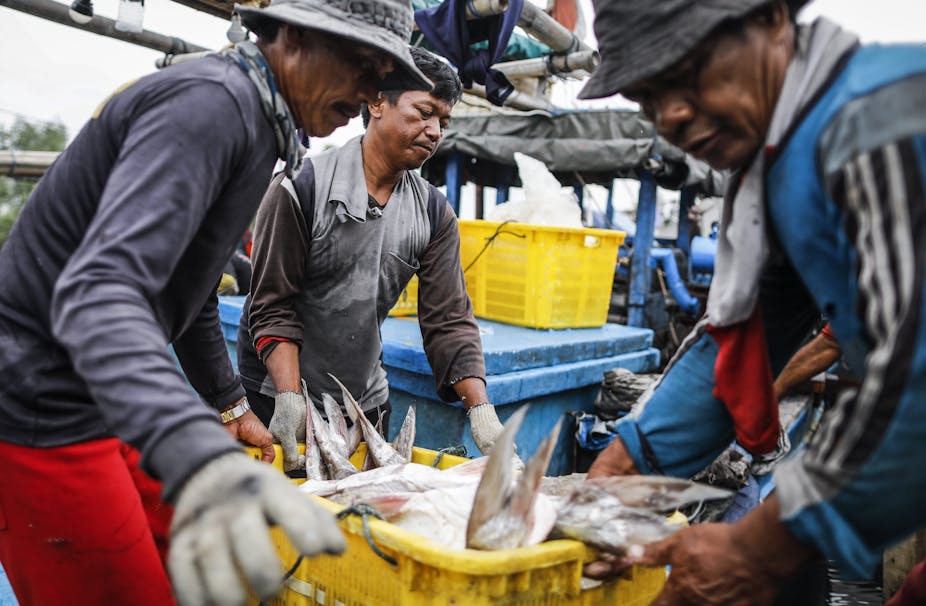Indonesia is known worldwide for its remarkable marine life. It lies at the heart of the Coral Triangle – an area that hosts 76% of the world’s coral species – and its marine sector accounts for over 6.5% of the country’s GDP.
At the south-western end of Sulawesi Island lies the Spermonde Archipelago. It is a rich and biodiverse region for coral reefs and fishery resources.
However, a recent academic report found a strong decrease in the amount of coral in Spermonde in the last few years, partly due to dynamite and cyanide fishing.
Such destructive fishing practices are widespread around South-East Asia and are a direct cause of death for corals and fish.

Our study conducted in 2014 in Spermonde indicates that “patron-client” systems, or what locals call “punggawa-sawi”, in the region’s commercial fisheries could foster these unsustainable practices.
This patronage system – common across South-East Asia – is essentially an informal credit system that bonds wealthy and well-connected individuals with many fishers through a reciprocal arrangement.
In exchange for favours such as loans for fishing equipment and protection, patrons receive benefits in the form of labour and exclusive catches.
However, this arrangement often ends up pushing their fishers to use techniques such as cyanide fishing to catch live fish – which are more valuable but harder to catch. This essentially endangers the coral reef ecosystems around them.
How the patron-client relationship works
In Spermonde, we found 53% of local fishermen were in a patron-client relationship, while only 37% were independent.
Fishers indebted to their patrons have to repay their loans slowly by selling their fishing catch exclusively to their patron, who sets the price and keeps track of the debt balance.
These fishermen are also expected to specialise in catching fish that their patron specialises in selling.
This situation places patrons in a unique position to affect the way fishing takes place – what species to target and which fishing methods to use.
From 2014 to 2015, we interviewed both independent fishermen and fishers in a patron-client relation in Spermonde. We also measured what they had caught and compared the catches of both types of fishermen.
Our study revealed that fishermen with patrons caught more valuable seafood – especially live fish. Independent fishermen landed more non-commercial items that they target to feed their families.
Specifically, 32% of the catch was live fish for fishermen with patrons, while only 19% for independent fishermen.
Valuable seafood is often caught by using potassium cyanide to stun the fish and catch it alive. These fish include species that are higher up in the food chain and typically take longer to replenish, such as groupers, Napoleon wrasse or Spanish mackerel.

Unfortunately, cyanide fishing can also indiscriminately kill a number of other species in the surrounding area and, more importantly, it kills the corals which are the foundation of the reef ecosystem.
While cyanide fishing is illegal in Indonesia, some studies indicate the existence of a network through which patrons usually bribe authorities and protect their fishermen from being prosecuted.
This confirms the extraordinary role of the patron-client system as an informal but dominant alternative governance system in the area.
Tapping into the patronage system for sustainability
Fisheries patronage has its critics and defenders.
Some studies point out patrons’ significant role in normalising illegal, destructive fishing practices and in trapping fishermen in perpetual debts.
On the other hand, a 2012 study explains how the patronage arrangement acts as an important social security system for local fishermen.
Besides ensuring fishers always have buyers for their catch, patrons provide fishermen and their families with financial resources to cope with bad fishing seasons or personal emergencies.
This means that patron-client systems – however destructive they currently are – do reduce fishermen’s socioeconomic vulnerability and remain a fundamental part of the social fabric of Spermonde’s small-scale fisheries.
In cases like Indonesia where enforcement capacity is limited and alternatives to fishing scarce, the government could recognise the patron-client system as a potential ally in the fight against unsustainable fishing practices.

Effective cessation of destructive fishing can produce remarkable recovery of fish populations.
For instance, some small-scale fisheries have shifted towards fishery certification programs as a result of the increasing market demand for sustainable products, which is likely the future path for fisheries.
We suggest patrons could ride this wave and become key actors, through their ability to reach a large number of small-scale fishers, to harness positive environmental attitudes and endorse sustainable fishing practices.
Of course, such a shift will not happen if the situation continues to favour illegal fishing.
To increase the cost for patrons to engage in illegal fishing, effective enforcement is crucial. This could be achieved by increasing the resources available to the competent authorities, such as the country’s Task Force 115, which is responsible for tackling illegal fishing.
Then, to make a shift towards sustainable fishing practices more attractive, the government could streamline the process for patrons to enter fishery certification programs and reward them with financial benefits, such as lower export taxes.
Offering environmental education and programs to build meaningful connections between local people and their coral reefs has also been proven to encourage people to abandon destructive fishing practices.


